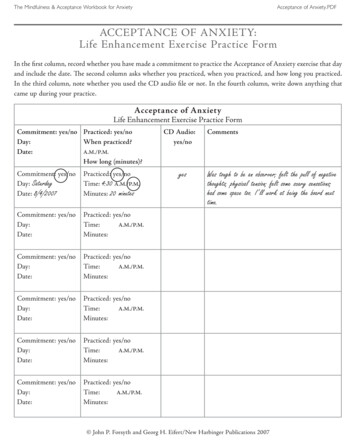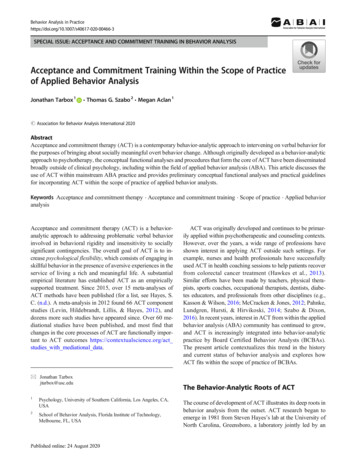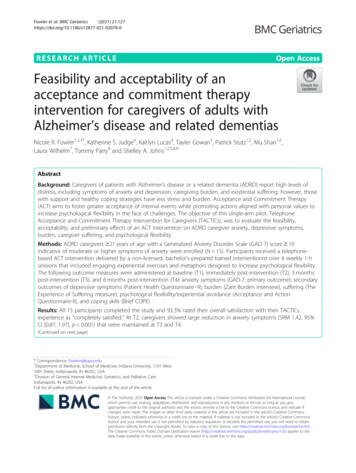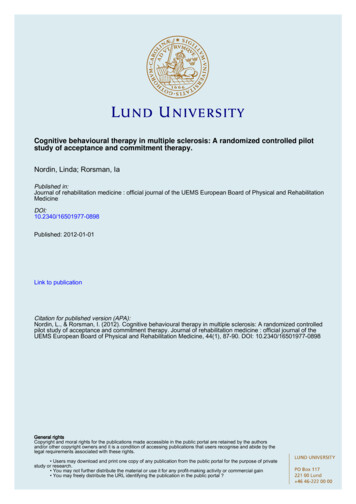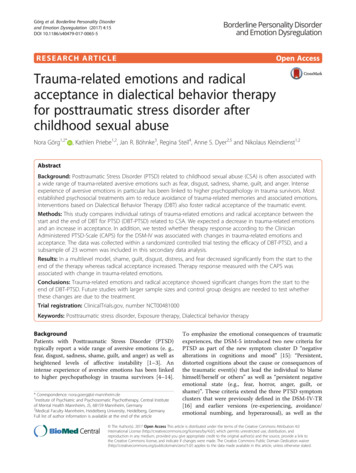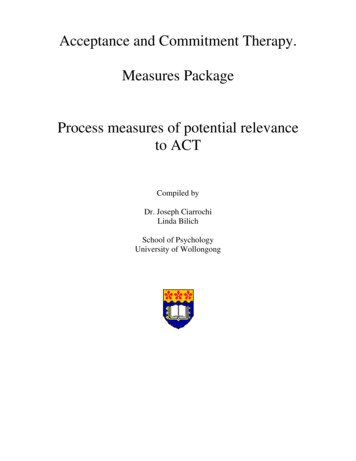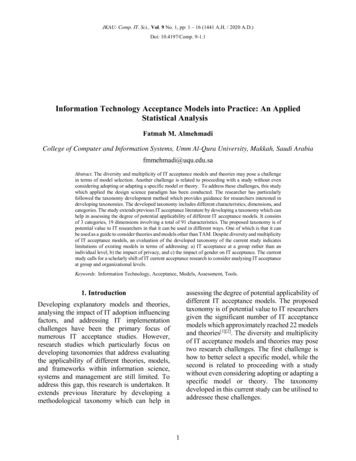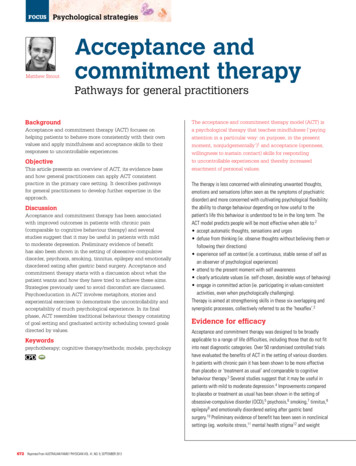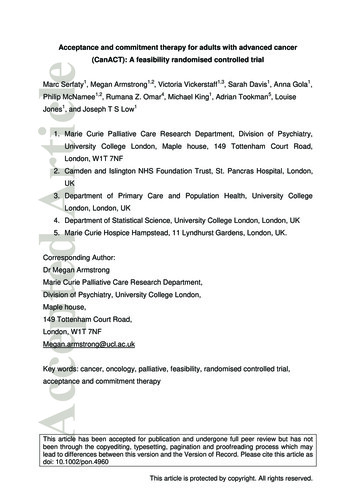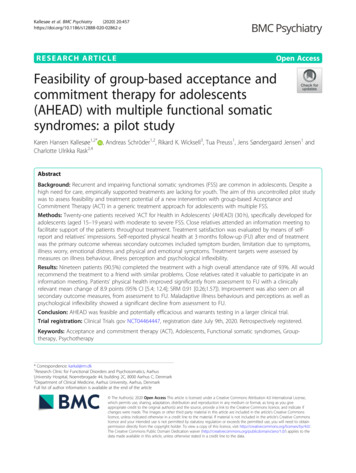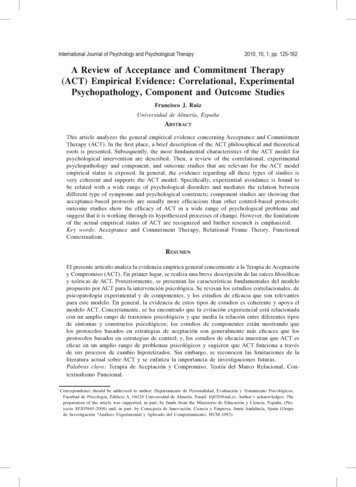
Transcription
International Journal of Psychology and Psychological Therapy2010, 10, 1, pp. 125-162A Review of Acceptance and Commitment Therapy(ACT) Empirical Evidence: Correlational, ExperimentalPsychopathology, Component and Outcome StudiesFrancisco J. RuizUniversidad de Almería, EspañaAbstractThis article analyzes the general empirical evidence concerning Acceptance and CommitmentTherapy (ACT). In the first place, a brief description of the ACT philosophical and theoreticalroots is presented. Subsequently, the most fundamental characteristics of the ACT model forpsychological intervention are described. Then, a review of the correlational, experimentalpsychopathology and component, and outcome studies that are relevant for the ACT modelempirical status is exposed. In general, the evidence regarding all these types of studies isvery coherent and supports the ACT model. Specifically, experiential avoidance is found tobe related with a wide range of psychological disorders and mediates the relation betweendifferent type of symptoms and psychological constructs; component studies are showing thatacceptance-based protocols are usually more efficacious than other control-based protocols;outcome studies show the efficacy of ACT in a wide range of psychological problems andsuggest that it is working through its hypothesized processes of change. However, the limitationsof the actual empirical status of ACT are recognized and further research is emphasized.Key words: Acceptance and Commitment Therapy, Relational Frame Theory, FunctionalContextualism.ResumenEl presente artículo analiza la evidencia empírica general concerniente a la Terapia de Aceptacióny Compromiso (ACT). En primer lugar, se realiza una breve descripción de las raíces filosóficasy teóricas de ACT. Posteriormente, se presentan las características fundamentales del modelopropuesto por ACT para la intervención psicológica. Se revisan los estudios correlacionales, depsicopatología experimental y de componentes, y los estudios de eficacia que son relevantespara este modelo. En general, la evidencia de estos tipos de estudios es coherente y apoya elmodelo ACT. Concretamente, se ha encontrado que la evitación experiencial está relacionadacon un amplio rango de trastornos psicológicos y que media la relación entre diferentes tiposde síntomas y constructos psicológicos; los estudios de componentes están mostrando quelos protocolos basados en estrategias de aceptación son generalmente más eficaces que losprotocolos basados en estrategias de control; y, los estudios de eficacia muestran que ACT eseficaz en un amplio rango de problemas psicológicos y sugieren que ACT funciona a travésde sus procesos de cambio hipotetizados. Sin embargo, se reconocen las limitaciones de laliteratura actual sobre ACT y se enfatiza la importancia de investigaciones futuras.Palabras clave: Terapia de Aceptación y Compromiso, Teoría del Marco Relacional, Contextualismo Funcional.*Correspondence should be addressed to author: Departamento de Personalidad, Evaluación y Tratamiento Psicológicos,Facultad de Psicología, Edificio A, 04120 Universidad de Almería. Email: frj939@ual.es. Author’s acknowledges: Thepreparation of the article was supported, in part, by funds from the Ministerio de Educación y Ciencia, España, (Proyecto SEJ05845-2008) and, in part, by Consejería de Innovación, Ciencia y Empresa, Junta Andalucía, Spain (Grupode Investigación "Análisis Experimental y Aplicado del Comportamiento, HUM-1093).
126RUIZAcceptance and Commitment Therapy (ACT; Hayes, Strosahl, & Wilson, 1999) isone of the most representative therapies of the so called third wave of behavior therapy(see Hayes, 2004 for a description of the three waves). ACT is a model of psychologicalintervention that is philosophically rooted in Functional Contextualism (Hayes, 1993;Hayes, Hayes, & Reese, 1988) and theoretically rooted in Relational Frame Theory(Hayes, Barnes-Holmes, & Roche, 2001). ACT is conceived as the treatment of theExperiential Avoidance Disorder (Hayes, Wilson, Gifford, Follette, & Strosahl, 1996;Wilson & Luciano, 2002), a functional dimensional approach to psychopathology.Functional contextualism is a pragmatic philosophy that was developed in orderto clarify some philosophical issues that could remain unclear in behavior analysisand, particularly, in radical behaviorism (Biglan, & Hayes, 1996; Hayes, Hayes, &Reese, 1988). In general, contextualism views events as ongoing actions in a context.These actions are whole events that can only been separated for pragmatic purposes.Functional contextualism is a specific variety of contextualism whose goals (and truthcriterion) are the prediction and the influence of events with precision, scope and depth(Hayes, 1993). Because its goals are prediction and influence, functional contextualismunderstands that every behavior has to be explained in terms of contextual variables,because, otherwise, it could not be influenced. Therefore, from this perspective, thoughtsand feelings do not directly cause other actions.As based on functional contextualism, ACT itself reflects it in some ways. Forexample, ACT emphasizes workability as a truth criterion. Therefore, thoughts are notseen as being correct or incorrect but seen as being useful in obtaining a more valuedlife. Also, since private events do not cause other behaviors, no attempt on changingthe content of private events would be necessary.Relational Frame Theory (RFT; Hayes et al., 2001) is a contextual behavioralapproach to human language and cognition that has growing empirical evidence. RFT isbased on the laws that were established within the functional analysis of behavior, but itrepresents a qualitative leap because it integrates disparate areas of behavioral researchsuch as equivalence relations and rule-following for doing an experimental analysis ofthe complex human behavior. The core RFT assumption is that human beings learn torelate stimuli under arbitrary contextual control, in other words, to relate stimuli thatdo not share formal properties. RFT defends that this is an operant behavior that islearned through a multiple exemplar training in which the abstraction of the contextualcue (e.g. “is”, “more than”, “contains”) that relates arbitrary stimuli is produced. Oncethe abstraction has been produced, this contextual cue (what is called relational frame)will be applicable to new stimuli without being necessary that they formed part of aprevious training.RFT proposes three requisites for considering the existence of a relational frame:mutual entailment, combinatorial entailment and transformation of functions. Mutualentailment involves the bidirectionality of stimuli relations in a way that if a personlearns that stimulus A is related in some way to stimulus B, then she/he will derive thatB is related in some way to A. For example, considering a relational frame of comparison, if a child is told that Juan is taller than Manuel, she/he will derive that Manuelis smaller than Juan. Combinatorial entailment involves that two or more stimuli that International Journal of Psychology & Psychological Therapy, 2010, 10, 1http://www. ijpsy. com
REVIEW OF ACT EVIDENCE127have acquired the property of mutual entailment can been combined. For example, if aperson learned that A and B were related in some way, and that B and C were relatedin some way; this person will be able to derive a relation between A and C without adirect training. In our example, if the child is told now that Manuel is taller than María,it will be derived that Juan is also taller than María, and, therefore, María is smallerthan Juan. The implication of mutual and combinatorial entailment is that a myriad ofstimuli relations can be learned without a direct training.Transformation of functions involves that the functions of one of the members ofa relational network can change the functions of the other members of the network. Inother words, having been taught the relations A-B, and B-C, if A acquires a reinforcingfunction, B and C functions will be affected according to the specific type of relationalnetwork that has been established between them. In our example, if the child is toldthat in order to play basketball, being taller is better, and we asked her/him to choosebetween Juan, Manuel and María, then the child would choose Juan.RFT has a large number of implications for the area of psychopathology andpsychotherapy that are extensions of the main concepts previously described. We willhighlight only some of them (see more extended reviews in Hayes et al., 1999; Törnekeet al., 2008; Wilson, Hayes, Greeg, & Zettle, 2001; Wilson & Luciano, 2002): 1) oncea person has a minimal relational repertoire, the transformation of aversive functionsaccording to the relations contained in a relational network cannot be prevented; 2)direct attempts of changing or suppressing the content of the relational networks is notpsychologically sound because it leads to an extension of the network (verbal relationswork by addition not by subtraction), and 3) since relational responding is contextuallycontrolled, it is possible to directly change the context of relational networks withoutchanging their content.In summary, RFT principles suggest that change attempts focused on the functionsof private events are more in accordance with the nature of language and cognition thanchange attempts focused on the content of them.Experiential Avoidance Disorder (EAD) or Destructive Experiential Avoidanceis a functional category that includes the most of the psychological disorders because,instead of their topographical differences, all of them share a same functional pattern:destructive experiential avoidance (see Boulanger, Hayes, & Pistorello, 2010 for a reviewof the areas in which experiential avoidance has been detected). Specifically, experientialavoidance has been defined as the occurrence of deliberate efforts to avoid and/or escapefrom private events such as affects, thoughts, memories and bodily sensations which areexperienced as aversive (Hayes et al., 1996; Luciano & Hayes, 2001). In other words,experiential avoidance is a functional class of behaviors that is negatively reinforcedby the effect of avoiding or diminishing some type of discomfort.Experiential avoidance is not problematic per se, but it becomes a problem whenit leads to psychological inflexibility, in other words, when it becomes a necessaryprevious step for doing valued actions. The problem with such a pattern of experiential avoidance is that it has a paradoxical effect. In the short run, avoidance behavioris reinforced but in the long run the feared private events are extended provoking theperson to act at the service of the feared private events throughout his or her life (seehttp://www. ijpsy. com International JournalofPsychology & Psychological Therapy, 2010, 10, 1
128RUIZTörneke et al., 2008, for a RFT conceptualization of the specific rule-governed behaviorinvolved in destructive experiential avoidance).Essential ACT principles and methodsThe principal aim of ACT is to dismantle the inflexible repertoire that characterizesEAD. ACT looks for generating psychological flexibility, in other words, to generatethe ability to contact the present moment more fully as a conscious human being, andto change or persist in behavior that serves their valued ends (Hayes, Masuda, Bond,Masuda, & Lillis, 2006). Furthermore, ACT proposes acceptance of the feared privateevents when the attempt to control them is counterproductive in the long term in orderto involving oneself in valued actions.The detailed description of ACT phases and methods is out of the scope of thepresent work (see Hayes et al., 1999; Wilson, & Luciano, 2002 for such descriptions).However, we will very briefly describe them. The therapeutic work in ACT can besummarized in two principles: (1) promoting values clarification and actions that arein accordance with such values; and (2) promoting defusion as a way to be involvedin the valued ends when the feared private events are present.The first point is implemented through the following phases: creative hopelessness,values clarification and the promotion of the willingness to experience the feared privateevents. The aim of creative hopelessness is to facilitate the patients’ discrimination ofthe short and long term effects of the actions that they are doing in order to control oravoid their feared private events, and experience the futility of trying to control them.The aim of values clarification is to facilitate patients to realize what is important intheir life and, if necessary, to establish a hierarchy of values. Finally, willingness toexperience the feared private events is promoted as a way to behave in accordance withthe chosen personal values.Cognitive defusion and experiencing self as a context are promoted to allowpatients to choose to behave in accordance with their values in the presence of discomfort or whatever other private events. ACT is not looking for a direct reduction ofthe discomfort, but to allow the patient to behave in a valued way in the presence ofit. Furthermore, ACT looks for changing the avoidance verbal functions of the fearedprivate events instead of looking for the change in their content. Cognitive defusioninvolves practicing to experience own thoughts, memories, sensations, etc., as the waythey are, weakening the tendency to treat them as facts. In cognitive defusion, promoting the experience of self as a context involves realizing that there is an I behind allprivate events that actually contains them. This allows the person to be aware of one’sown flow of experiences without being attached to them and, from this perspective, tochoose to avoid discomfort or involve in valued actions in spite of its presence.In order to obtain its objectives, ACT makes use of paradoxes, metaphors andexperiential exercises. Experiential and exposure exercises are very important in ACT.However, it is worth noting that exposure exercises have a different rationale than insecond wave therapies. While classic exposure exercises are conducted in order topromote the extinction of discomfort, exposure exercises in ACT are carried out for International Journal of Psychology & Psychological Therapy, 2010, 10, 1http://www. ijpsy. com
REVIEW OF ACT EVIDENCE129training the patients to be present with their feared private events and to choose tobehave in a valued way.A summary of ACT empirical reviewsThe first critique was provided by Corrigan (2001). This author warmed that ACT,and other recent behavioral therapies, have been developed ahead of the data. Althoughthis was partially true at that time, it should be taken into consideration that ACT hasnot been developed with the usual rationale (see Zettle, 2005), since the philosophicaland theoretical roots were developed first. However, only 3 years later, there were 10published ACT controlled studies and 15 case studies (Hayes, Masuda, Bissett, Luoma,& Guerrero, 2004). A couple of years later, the first exhaustive review of ACT empiricalevidence was published (Hayes et al., 2006). This review contained the correlationalevidence concerning experiential avoidance, the experimental psychopathology and ACTcomponent studies, the randomized controlled trials (RCT) and processes of change studies. Specifically, over 20 RCTs, the authors reported that ACT was superior to controlconditions, wait-lists and treatment as usual (TAU) (d .99 at post-treatment and d .71 at follow-up) and superior to structured interventions (d .48 at post-treatment andd .63 at follow-up).Subsequently, Öst (2008) carried out a qualitative and quantitative review of theACT empirical evidence from RCTs. The reported effect sizes were very similar to onespresented by Hayes et al. (2006). Specifically, over the 15 RCTs considered, the effectsizes were: d .96 versus no treatment control condition, d .79 versus TAU, and d .53 versus active treatments. In order to establish a path for comparing ACT versusCognitive Behavioral Therapy (CBT), this author selected a “twin” CBT study publishedin the same journal within a difference no greater than one year. The conclusion wasthat ACT studies showed lower scores in a methodological scale compared with CBTstudies. Finally, Öst (2008) concluded that ACT does not fulfill the criteria for beingconsidered as an empirical validated treatment (Chambless & Ollendick, 2001).However, Gaudiano (2009) has conducted a re-analysis of this review. According to it, 38% of the ACT studies could not be “matched” with a CBT study becausethe studies were conducted over different disorders. In fact, most of the ACT studiesdescribed treatments implemented to more difficult problems shown by more resistantpopulations than the CBT studies did (specifically, ACT: 2 studies in depression, 3 inanxiety disorders, 2 in chronic medical conditions, 2 with psychotic symptoms, 2 inaddictions, 1 in chronic pain and 1 in borderline personality disorder; while CBT: 2studies in depression and 11 in anxiety disorders). Another relevant issue was that CBTstudies were 4.5 more times funding than ACT studies were. Furthermore, the differencein the methodological rigor between CBT and ACT studies could be due to these twofactors (the more difficult problems treated in ACT studies and the difference in fundingthat ACT and CBT studies received).More recently, Powers, Zum Vörde Sive Vörding, & Emmelkamp (2009) haveconducted another meta-analytic review of ACT empirical evidence in RCT studies. Theconclusions of this review were that ACT is better than wait-lists and placebo attentionhttp://www. ijpsy. com International JournalofPsychology & Psychological Therapy, 2010, 10, 1
130RUIZconditions (g .68), better than TAU (g .42), but not significantly better than established treatments (g .18; p .13). However, Levin & Hayes (2009) have re-analyzedthe database reported by Powers et al. (2009) concluding that ACT was better thanestablished treatments (g .27; p .03).In sum, during the last years several controversies have appeared with respect tothe empirical status of ACT. These controversies have been focused on a specific typeof studies (the RCTs), comparing the differential effect of ACT versus other conditionsand comparing the methodology of ACT studies with those employed in CBT studies.Accordingly to these studies: (1) ACT is better than control and TAU conditions (Hayeset al., 2006; Öst, 2008; Power et al., 2009); (2) more evidence is needed in order todetermine if ACT is better than established treatments (Levin & Hayes, 2009; Powerset al., 2009); (3) the RCTs conducted in ACT literature can be methodologically improved (Öst, 2008), although such limitations are characteristic of the earlier RCTs ofany emerging psychotherapeutic approach (Gaudiano, 2009).However, in our opinion, the debate has been narrowed into very specific issuesand a global vision of the ACT model characteristics and empirical evidence has beenlost. About four years have passed since the Hayes et al. (2006) global review of ACTmodel, and a good number of studies have been conducted during this time. The aimof this article is to summarize the current evidence of the ACT model to take a globalvision of the singular characteristics of it.Empirical evidence of ACT modelTo review the ACT empirical evidence, studies will be separated as: correlationalstudies, experimental psychopathology and component studies, outcome studies and casestudies. We will cover all published articles and other available data (e. g., dissertations,submitted articles, etc.). We believe that this review references nearly all the extantACT literature as Winter 2009.Correlational StudiesThe main aim of correlational studies has been to study the relationships amongexperiential avoidance and psychological symptoms and other psychological constructs.Most of the studies have used the Acceptance and Action Questionnaire (AAQ; Hayes etal., 2004). This questionnaire is a general measure of experiential avoidance with severalversions according to the number of items. A new version is now available, the AAQ-II(Bond et al., under review) that has better psychometric properties and factorial structure.AAQ has been adapted to several specific domains in order to measure change processesof ACT interventions (for example, the Chronic Pain Acceptance Questionnaire: CPAQ;McCracken, Vowles, & Eccleston, 2004) and specific populations (see the Avoidanceand Fusion Questionnaire: AFQ; Greco, Lambert, & Baer, 2008). Note that AAQ hasbeen keyed both positively and negatively in the literature, depending on what peoplewould like to emphasize: experiential avoidance or acceptance/psychological flexibility.In this paper, we will use the scores as an indication of experiential avoidance. International Journal of Psychology & Psychological Therapy, 2010, 10, 1http://www. ijpsy. com
REVIEW OF ACT EVIDENCE131A detailed review of correlations on experiential avoidance and symptoms andpsychological constructs is out of the scope of the present work, but the synthesis isthat experiential avoidance is positively related with virtually all the psychologicalsymptoms and negatively rekated with quality of life and general health measures (Hayeset al., 2006). We are only going to actualize the data provided by Hayes et al. (2006)with those published since it with respect to the relation of experiential avoidance anddepression and anxiety symptoms. The picture is as follows.As shown in Table 1, 20 studies have obtained 22 correlations between someversion of AAQ and standard measure of depressive symptoms. Correlations have beenpositive in a range between r .37 and r .77. Taking into account all the studies (with3323 participants), the weigthed correlation is r .55. With respect to anxiety symptoms,14 studies has been conducted (with 3043 participants), reporting correlations betweenr .16 to r .76. The weigthed correlation across studies is r .52.Table 1. Corelations between experiential avoidance and symptoms of depression and anxiety.http://www. ijpsy. com International JournalofPsychology & Psychological Therapy, 2010, 10, 1
132RUIZMore than 30 longitudinal and mediational studies have analyzed the role ofexperiential avoidance over different types of symptoms and psychological constructs.Chronic pain is the field with more studies. Specifically, Kratz, Davis, & Zautra (2007)have showed that acceptance of pain predicted posterior positive affect. Esteve, RamírezMaestre, & López Martínez (2007) showed that pain acceptance determined the functional status and functional disability. In McCracken & Vowles (2007), pain acceptanceexplained a significant part of the variance in 8 different measures of functioning; inWicksell, Renöfält, Olsson, Bond, & Melin (2008) acceptance predicted pain severity,pain interference in everyday life and physical and mental well being; in Vowles, McCracken, & Eccleston (2008) acceptance mediated the effects of catastrophizing thoughts,depression and anxiety. Acceptance of pain and valued directed behavior accounted fora significant variance of pain, anxiety, depression and physical disability (McCracken& Vowles, 2008). As measure of acceptance, persistence in an activity was associatedwith a better long term functioning over time while control-oriented responses wereassociated with greater difficulty (McCracken, Vowles, & Gaurlett-Gilbert, 2007). McCracken & Eccleston (2006) found that acceptance variables were stronger predictors ofdistress and disability compared with several coping strategies. General psychologicalacceptance added a significant increment of explained variance to the prediction of patient functioning (McCracken & Zhao-O’Brien, in press). Also, McCracken & Velleman(2010) showed that psychological flexibility accounted for more variance in measuresof health than pain intensity.In work settings, the level of experiential avoidance has predicted mental health(Bond & Bunce, 2003; Donaldson-Feilder & Bond, 2004) and the performance in learninga new software, mental health and work performance (Bond, & Flaxman, 2006).With respect to stressful vital events, experiential avoidance has showed to bea mediator between the stress of having a preterm birth and the postdischarge adjustment (Greco, Heffner, Ritchie, Polak, Poe, & Lynch, 2005), between the September 11terrorist attacks and anxiety problems (Farach, Mennin, Smith, & Mandelbaum, 2008)and between internalized homophobia and PTSD symptoms in sexual assault survivorsof the same sex person (Gold, Dickstein, Marx, & Lexington, 2009; Gold, Marx, &Lexington, 2007).Experiental avoidance has also been a mediator between childhood psychologicalabuse and current mental health symptoms (Reddy, Pickett, & Orcutt, 2005), betweenperceived criticism in the family of origin and the resulting distress (Rosenthal, Polusny, & Follette, 2006), between maladaptive perfectionism and worry (Santanello &Gardner, 2006), between objective and subjective quality of life in the elderly (Butler& Ciarrochi, 2007), between several dysfunctional beliefs and hair-pulling severity(Norberg, Wetterneck, Woods, & Conelea, 2007) between skin picking and depressiveand anxiety symptoms in chronic skin picking patients (Flessner & Woods, 2006), between materialistic values and different dimensions of well-being (Kashdan & Breen,2007), between anxiety sensitivity and Borderline Personality Disorder (Gratz, Tull,& Gunderson, 2008) and depression (Tull & Gratz, 2008), between social anxiety andposttraumatic stress in quality of life (Kashdan, Morina, & Priebe, 2008), and betweentinnitus and depression and quality of life (Westin, Hayes, & Andersson, 2008). Expe International Journal of Psychology & Psychological Therapy, 2010, 10, 1http://www. ijpsy. com
REVIEW OF ACT EVIDENCE133riential avoidance accounted for a relevant part of the variance in aggressive behavior(Tull, Jakupack, Paulson, & Gratz, 2007) and moderated the relation between automaticalcohol motivation and hazardous drinking (Ostafin & Marlatt, 2007). Finally, Berking,Neacsiu, Comtois, & Linehan (2009) obtained data that are coherent with the hypothesis that experiential avoidance impedes the reduction of depression in the treatment ofBorderline Personality Disorder.Experimental psychopathology and ACT component studiesThree types of studies have been conducted: studies focused on the effect ofexperiential avoidance repertoire in some experimental task, those focused on theeffect of acceptance coping instructions, and those focused on the effect of brief ACTprotocols.Studies about the effect of Experiential Avoidance repertoire in experimental tasks.The predictive power of the level of experiential avoidance in participants’ performance inexperimental tasks has been obtained by selecting participants with high and low scoresin AAQ. For example, with a cold pressor task, participants with higher scores in AAQhad lower tolerance and kept their hand in the cold water for less time than participantswith lower AAQ scores (Zettle et al., 2005) and lasted more time in recovering (Feldner,Hekmat, Zvolensky, Vowles, Secrist, & Leen-Feldner, 2006). Similarly, in a study inwhich an experimental task simulated the effect of being drunk, participants with higherscores in AAQ evaluated the induced sensations of the task as more discomforting andhad a worse performance on a challenging perceptual-motor task than the participantswith low scores in AAQ (Zettle, Petersen, Hocker, & Provines, 2007).Using a carbon dioxide-enriched air challenge, Feldner, Zvolensky, Eifert, &Spira (2003) evaluated the effect of acceptance versus suppression protocols with participants with high and low AAQ scores. Participants with high levels of AAQ showedmore anxiety and emotional discomfort, but not more physiological activation. Also,participants with high AAQ scores who received the suppression protocol showed higher levels of anxiety than those who received the acceptance protocol. Using this sametask, Karekla, Forsyth, & Kelly (2004) observed that participants with high experientialavoidance showed more panic related symptoms, however, there were not differencesbetween high and low AAQ participants in the physiological measures.Sloan (2004) compared the emotional reactions of participants during the viewingof pleasant, neutral, and unpleasant films. Participants with high level of experientialavoidance showed higher emotional experience and higher heart rate with the pleasant andunpleasant films than participants with lower levels. In a similar study, participants withhigher AAQ scores showed more discomfort, negative affect and electrodermal responseduring the viewing of an emotional film (Salters-Pedneault, Gentes, & Roemer, 2007).Finally, Cochrane, Barnes-Holmes, Barnes-Holmes, Stewart, & Luciano (2007) reportedthat participants with higher level of experiential avoidance showed higher latency inthe selection of a response that involved the posterior presentation of unpleasant images.Also, the data of the event-related potentials suggested that this group of participantsengaged in verbal strategies to regulate their emotional responses.http://www. ijpsy. com International JournalofPsychology & Psychological Therapy, 2010, 10, 1
134RUIZEffect of acceptance coping instructions. An alternative experimental strategy hasbeen to compare instructions that summarize different coping strategies while doing anexperimental task that involved aversive stimulation. Keogh, Bond, Hanmer, & Tilston (2005) used a cold-pressor task and showed that an acceptance coping instructionobtained better results than one distraction coping instruction with women, albeit bothinstructions had the same effect with men.Marcks & Woods (2005) compared the effect of suppression versus acceptanceinstructions in the management of intrusive thoughts. Results showed that particip
Acceptance and Commitment Therapy (ACT; Hayes, Strosahl, & Wilson, 1999) is one of the most representative therapies of the so called third wave of behavior therapy (see Hayes, 2004 for a description of the three waves). ACT is a model of psychological intervention that is philosophically rooted in Functional Contextualism (Hayes, 1993;
